Belkin F5D8013D N Wireless Notebook Card User Manual P75448 A F5D8013 man indd
Belkin International, Inc. N Wireless Notebook Card P75448 A F5D8013 man indd
Belkin >
Contents
- 1. Manual part 1
- 2. Manual Part 2
- 3. Manual Part 3
Manual part 1

Belkin Ltd.
Express Business Park, Shipton Way
Rushden, NN10 6GL, United Kingdom
+44 (0) 1933 35 2000
+44 (0) 1933 31 2000 fax
Belkin Ltd.
4 Pioneer Avenue
Tuggerah Business Park
Tuggerah, NSW 2259, Australia
+61 (0) 2 4350 4600
+61 (0) 2 4350 4700 fax
Belkin B.V.
Boeing Avenue 333
1119 PH Schiphol-Rijk, The Netherlands
+31 (0) 20 654 7300
+31 (0) 20 654 7349 fax
Belkin Tech Support
US: 877-736-5771
800-223-5546 ext. 2263
310-898-1100 ext. 2263
UK: 0845 607 77 87
Australia: 1800 235 546
New Zealand: 0800 235 546
Singapore: 65 64857620
Europe: www.belkin.com/support
Belkin International, Inc.
501 West Walnut Street
Los Angeles, CA 90220-5221, USA
310-898-1100
310-898-1111 fax
© 2007 Belkin International, Inc. All rights reserved. All trade names are registered trademarks of
respective manufacturers listed. Windows and Windows Vista are either registered trademarks or
trademarks of Microsoft Corporation in the United States and/or other countries.
P75448-A
N Wireless
Notebook Card
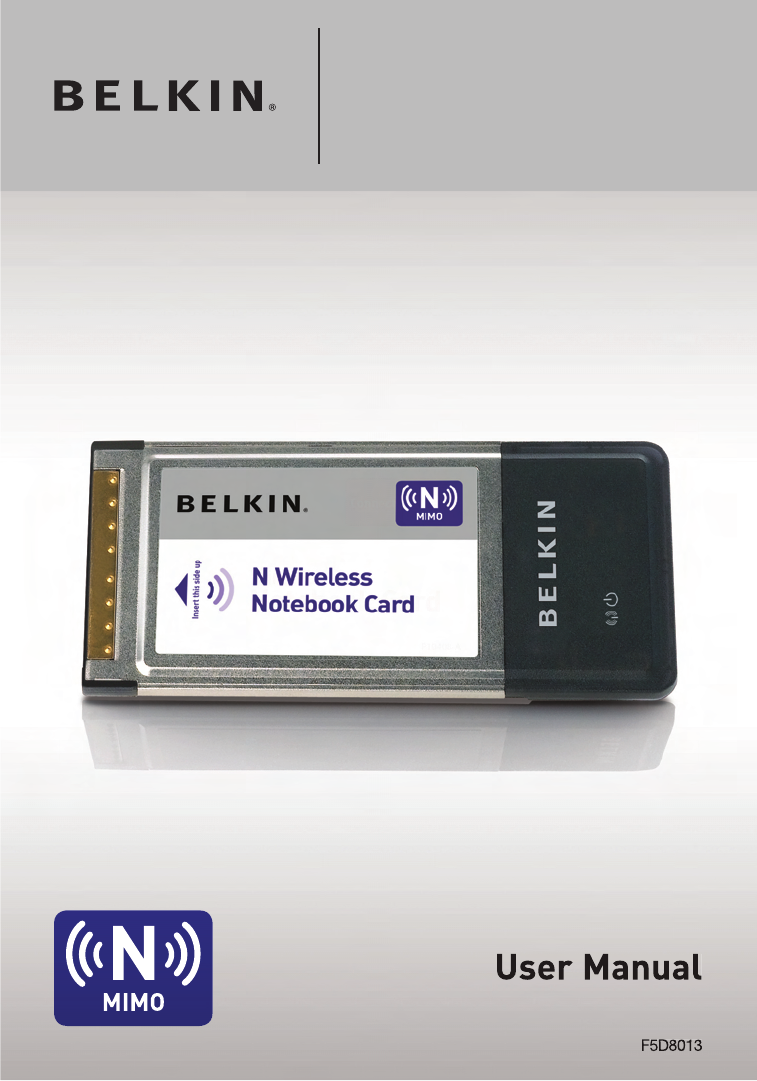
N Wireless
Notebook Card
v4

Table of Contents
1 Introduction
1 Introduction
. . . . . . . . . . . . . . . . . . . . . . . . . . . . . . . . . . . . . . . . . . . . . . . . . . . . . .
1
Benefits of a Home Network
. . . . . . . . . . . . . . . . . . . . . . . . . . . . . . . . . . . . . .
1
Advantages of a Wireless Network
. . . . . . . . . . . . . . . . . . . . . . . . . . . . . . . . .
1
Placement of your Wireless Networking Hardware
for
Optimal Performance
. . . . . . . . . . . . . . . . . . . . . . . . . . . . . . . . . . . . . . . . .
2
2 Overview
. . . . . . . . . . . . . . . . . . . . . . . . . . . . . . . . . . . . . . . . . . . . . . . . . . . . . . . .
5
Product Features
. . . . . . . . . . . . . . . . . . . . . . . . . . . . . . . . . . . . . . . . . . . . . . .
5
Applications and Advantages
. . . . . . . . . . . . . . . . . . . . . . . . . . . . . . . . . . . . .
6
Product Specifications
. . . . . . . . . . . . . . . . . . . . . . . . . . . . . . . . . . . . . . . . . . .
6
System Requirements
. . . . . . . . . . . . . . . . . . . . . . . . . . . . . . . . . . . . . . . . . .
7
Package Contents
. . . . . . . . . . . . . . . . . . . . . . . . . . . . . . . . . . . . . . . . . . . . .
7
3 Installing and Setting up the Card
. . . . . . . . . . . . . . . . . . . . . . . . . . . . . . . . . . .
8
A — Installation Process for Windows Vista
. . . . . . . . . . . . . . . . . . . . . . . . .
8
B — Installation Process for Windows Operating Systems
other than Windows Vista
. . . . . . . . . . . . . . . . . . . . . . . . . . . . . . . . . . . . . . . .
other than Windows Vista . . . . . . . . . . . . . . . . . . . . . . . . . . . . . . . . . . . . . . . .other than Windows Vista
1
2
C — Configuration
. . . . . . . . . . . . . . . . . . . . . . . . . . . . . . . . . . . . . . . . . . . . .
1
5
4 Using the Belkin Wireless
Networking Utility
. . . . . . . . . . . . . . . . . . . . . . . .
16
Accessing the Belkin Wireless Networking Utility
from the Windows System Tray
. . . . . . . . . . . . . . . . . . . . . . . . . . . . . . . . . .
from the Windows System Tray . . . . . . . . . . . . . . . . . . . . . . . . . . . . . . . . . .from the Windows System Tray
1
6
Network Status
. . . . . . . . . . . . . . . . . . . . . . . . . . . . . . . . . . . . . . . . . . . . . . .
17
Available Networks
. . . . . . . . . . . . . . . . . . . . . . . . . . . . . . . . . . . . . . . . . . . .
17
Setting Wireless Network Profiles
. . . . . . . . . . . . . . . . . . . . . . . . . . . . . . . . .
1
9
Securing your Wi-Fi Network
. . . . . . . . . . . . . . . . . . . . . . . . . . . . . . . . . . . .
Securing your Wi-Fi Network . . . . . . . . . . . . . . . . . . . . . . . . . . . . . . . . . . . .Securing your Wi-Fi Network
1
9
Configuring your Card to use Security
. . . . . . . . . . . . . . . . . . . . . . . . . . . . .
23
5 Troubleshooting
. . . . . . . . . . . . . . . . . . . . . . . . . . . . . . . . . . . . . . . . . . . . . . . . .
36
6 Information
. . . . . . . . . . . . . . . . . . . . . . . . . . . . . . . . . . . . . . . . . . . . . . . . . . . . .
45

Introduction
section
1
1
2
3
4
5
6
Thank you for purchasing the Belkin N Wireless Notebook Card. Now
Thank you for purchasing the Belkin N Wireless Notebook Card. Now
you can take advantage of this great new technology and gain the
freedom to network your home and office computers wirelessly. This
Card allows you to connect a notebook computer to your network.
Please be sure to read through this User Manual completely, and pay
special attention to the section entitled “Placement of your Wireless
Networking Hardware for Optimal Performance”.
Benefits of a Home Network
Your Belkin Home Network will allow you to:
• Share one high-speed Internet connection with all the computers in
your home
• Share resources, such as files, and hard drives among all the
connected computers in your home
• Share a single printer with the entire family
• Share documents, music, video, and digital pictures
• Store, retrieve, and copy files from one computer to another
• Simultaneously play games online, check Internet email, and chat
Advantages of a Wireless Network
Advantages of a Wireless Network
•
Mobility
– you’ll no longer need a dedicated “computer
room”— now you can work on a networked laptop or desktop
computer anywhere within your wireless range
•
Easy installation
– Belkin Easy Installation Wizards make
setup simple
•
Flexibility
– set up and access printers, computers, and
other networking devices from anywhere in your home
•
Easy expansion
– the wide range of Belkin networking products
lets you expand your network to include devices such as printers
and gaming consoles
•
No cabling required
– you can spare the expense and hassle
of retrofitting Ethernet cabling throughout the home or office
•
Widespread industry acceptance
– choose from a wide range
of interoperable networking products

Introduction
2
Placement of your Wireless Networking Hardware for
Placement of your Wireless Networking Hardware for
Optimal Performance
Your wireless connection will be stronger the closer your computer is
to your wireless router (or access point). Typical indoor operating range
for your wireless devices is between 100 and 200 feet. In the same way,
your wireless connection and performance will degrade somewhat as the
distance between your wireless router (or access point) and connected
devices increases. This may or may not be noticeable to you. As you
move farther from your wireless router (or access point), connection
speed may decrease. Factors that can weaken signals simply by getting
in the way of your network’s radio waves are metal appliances or
obstructions, and walls.
If you have concerns about your network’s performance that might be
related to range or obstruction factors, try moving the computer to a
position between five and 10 feet from the wireless router (or access
point) in order to see if distance is the problem. If difficulties persist even
at close range, please contact Belkin Technical Support.
Note:
While some of the items listed below can affect network
performance, they will not prohibit your wireless network from
functioning; if you are concerned that your network is not operating at its
maximum effectiveness, this checklist may help.
1. Placement of your Wireless Router (or Access Point)
Place your wireless router (or access point), the central connection point
of your network, as close as possible to the center of your wireless
network devices.
To achieve the best wireless network coverage for your “wireless clients,”
(i.e. computers enabled by Belkin Wireless Notebook Cards, Wireless
Desktop Cards, and Wireless USB Adapters):
•
Ensure that your wireless router’s (or access point’s) antennas
are parallel to each other, and are positioned vertically (toward
the ceiling). If your wireless router (or access point) itself is
positioned vertically, point the antennas as much as possible in
an upward direction.
•
In multistory homes, place the wireless router (or access point)
on a floor that is as close to the center of the home as possible.
This may mean placing the wireless router (or access point) on
an upper floor.
•
Try not to place the wireless router (or access point) near a
cordless 2.4GHz phone.

Introduction
section
3
1
2
3
4
5
6
2.
2.
Avoid Obstacles and Interference
Avoid Obstacles and Interference
Avoid placing your wireless router (or access point) near devices that
Avoid placing your wireless router (or access point) near devices that
may emit radio “noise”, such as microwave ovens. Other objects that
can inhibit wireless communication can include:
• Refrigerators
• Washers and/or dryers
• Metal cabinets
• Large aquariums
• Metallic-based, UV-tinted windows
If your wireless signal seems weak in some spots, make sure that
objects such as these are not blocking the signal’s path between
your computers and wireless router (or access point).
3. Cordless Phone Placement
If the performance of your wireless network is impaired after attending
If the performance of your wireless network is impaired after attending
to the above issues, and you have a cordless phone:
•
Try moving cordless phones away from the wireless router
(or access point) and your wireless-enabled computers.
• Unplug and remove the battery from any cordless phone
that operates on the 2.4GHz band (check manufacturer’s
information). If this fixes the problem, your phone may
be interfering.
•
If your phone supports channel selection, change the
channel on the phone to the farthest channel from your
wireless network as possible. For example, change the
phone to channel 1 and move your wireless router (or
access point) to channel 11. (Your channel selection will vary
depending on your region.) See your phone’s user manual for
detailed instructions.
•
If necessary, consider switching to a 900MHz or
5GHz cordless phone.

Introduction
444
4. Choose the “Quietest” Channel for your Wireless Network
In locations where homes or offices are close together, such as
apartment buildings or office complexes, there may be wireless
networks nearby that can conflict with yours. Use the Site Survey
capabilities of your Wireless Networking Utility to locate any other
wireless networks, and move your wireless router (or access point) and
computers to a channel as far away from other networks as possible.
Experiment with more than one of the available channels, in order to
find the clearest connection and avoid interference from neighboring
cordless phones or other wireless devices.
For more Belkin wireless networking products, use the detailed Site
Survey and wireless channel information included in your User Manual.
5. Secure Connections, VPNs, and AOL
Secure connections typically require a user name and password, and
are used where security is important. Secure connections include:
• Virtual Private Network (VPN) connections, often used to
connect remotely to an office network
• The “Bring Your Own Access” program from America Online
(AOL), which lets you use AOL through broadband provided by
another cable or DSL service
• Most online banking websites
• Many commercial websites that require a user name and
password to access your account
Secure connections can be interrupted by a computer’s power
management setting, which causes it to “go to sleep.” The simplest
solution to avoid this is to simply reconnect by re-running the VPN or
AOL software, or by re-logging into the secure website.
A second alternative is to change your computer’s power management
settings so it does not go to sleep; however, this may not be
appropriate for portable computers. To change your power management
setting in Windows, see the “Power Options” item in the Control Panel.
If you continue to have difficulty with Secure Connections, VPNs, and
AOL, please review steps 1–4 above to be sure you have addressed
these issues.
These guidelines should allow you to cover the maximum possible area
with your wireless router. Should you need to cover an even wider area,
we suggest the Belkin Wireless Range Extender/Access Point.
For more information regarding our networking products, visit our
website at
www.belkin.com/networking
or call Belkin Technical Support.

Overview
section
555
2
3
4
5
6
Product Features
The Card complies with the IEEE draft-802.11n specification to
communicate with other draft-802.11n-compliant wireless devices at
up to 300Mbps*. The Card is also compatible with 802.11g devices at
54Mbps as well as 802.11b products at 11Mbps. The Card operates
on the same 2.4GHz frequency band as 802.11b/g Wi-Fi
®
products.
• 2.4GHz ISM (Industrial, Science, and Medical)
band operation
• Integrated easy-to-use Wireless Networking Utility
• PCI interface, for operation in virtually any desktop computer
• WPA, WPA2, 64-bit WEP (Wired Equivalent Privacy), or
128-bit encryption
• Wireless access to networked resources
• Support for both Infrastructure and Ad-Hoc (peer-to-peer)
networking modes
•
Data rate of up to 54Mbps (802.11g), or 11Mbps (802.11b)
• Easy installation and use
• External antenna
• LED power and network link indicators
1

Overview
6
Applications and Advantages
Applications and Advantages
•
Wireless roaming with a laptop around the home or office
Offers the freedom of networking—without cables
•
Connection rates of up to 54Mbps
Provides immediate wireless connectivity at home, work, and hotspot
locations without compromising the use of existing 802.11b and
802.11g products
•
Compatibility with 802.11b products
802.11g wireless LAN solutions are backward-compatible with existing
Wi-Fi (IEEE 802.11b) products and with other products that display the
Wi-Fi (IEEE 802.11b) products and with other products that display the
54g logo
•
Difficult-to-wire environments
Enables networking in buildings with solid or finished walls, or open
areas where wiring is difficult to install
•
Frequently changing environments
Adapts easily in offices or environments that frequently rearrange or
change locations
•
Temporary LANs for special projects or peak time
Sets up temporary networks such as at trade shows, exhibitions, and
construction sites, which need networks on a short-term basis; also
companies who need additional workstations for a peak activity period
•
SOHO (Small Office/Home Office) networking needs
Provides the easy and quick, small network installation SOHO
users need
Product Specifications
Host Interface: 32-bit CardBus
Operating Temperature: 32–140 degrees F (0–60 degrees C)
Storage Temperature: -40–194 degrees F (-40–90 degrees C)
Humidity: Max. 95% (non-condensing)
Typical Operating Range: Up to 1,200 ft. (365.8m)**
*NOTE
: The standard transmission rate—300Mbps—is the physical data
rate. Actual data throughput will be lower.
**Wireless performance
may vary depending on the
networking environment.
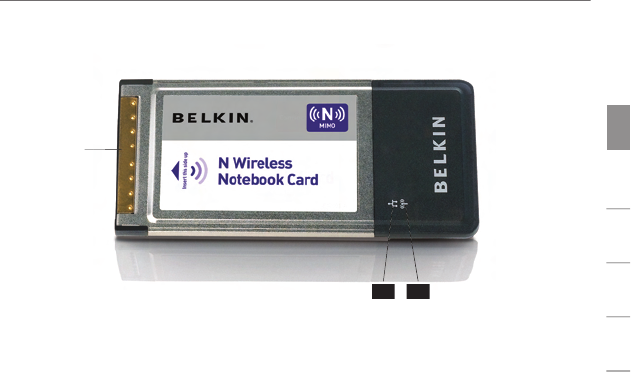
Overview
section
7
1
2
3
4
5
6
(a) Power LED
Lights up when the Card is powered up
(b) Link/Activity LED
Lights up when the Card is connected; flashes when
wireless activity is detected
(c) Card Connector
Part of the Card that fits into your computer’s CardBus slot
System Requirements
•
PC-compatible computer with one available 32-bit, CardBus slot
• Windows
®
2000, XP with SP2, or Vista
™
***
(clients are not Mac OS compatible)
• Minimum 64MB of RAM
• CD-ROM drive
• Internet browser
Package Contents
• N Wireless Notebook Card
• Quick Installation Guide
• Installation Software and User Manual on CD-ROM
(b)
(b)
(c)
(a)
(a)
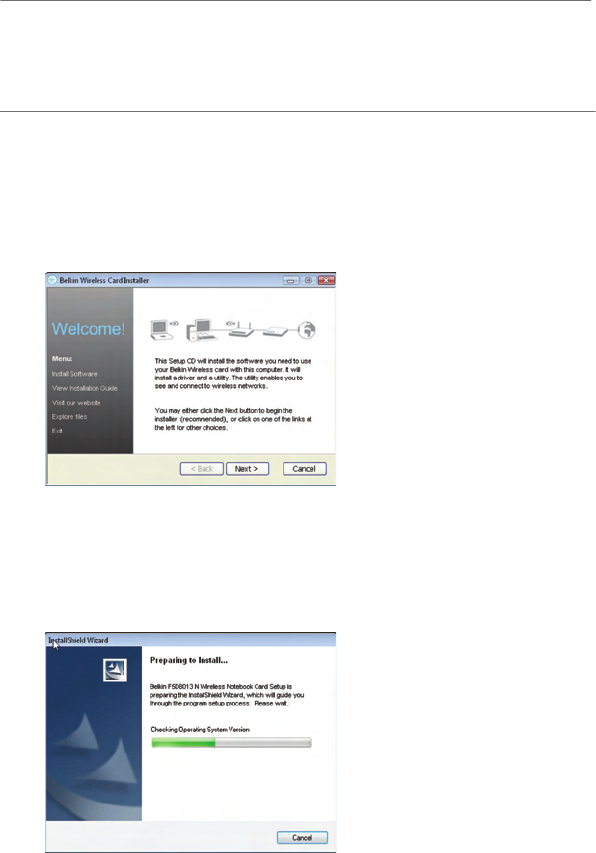
Installing and Setting up the Card
8
A. Installation Process for Windows Vista
***NOTE:
For information on updated drivers, please visit the Belkin
website at www.belkin.com/support.
IMPORTANT:
INSTALL THE SOFTWARE BEFORE INSERTING THE CARD.
A.1
Insert the Installation Software CD into your CD-ROM drive.
A.2
Click “Next” to begin the installation process.
Note:
If the Belkin Wireless Card Installer screen does not appear
within 20 seconds, access your CD-ROM by double-clicking on the
“My Computer” icon; then, double-click on the CD-ROM drive into
which the installation CD has been placed. If the Installer does not start
automatically, double-click on the icon named “Setup.exe”.
A.3
The InstallShield Wizard starts installation process.

Installing and Setting up the Card
section
9
1
2
3
4
5
6
A.4
Select a destination folder for the
software installation by clicking
“Browse”; or, simply click “Next” to
select a default location.
A.5
A Setup Status screen will let
you know where you are in the
setup process.
A.6
A window may appear a second
time showing the message,
“Windows can’t verify the
publisher of this driver software”.
This DOES NOT indicate a
problem. Our software has been
fully tested and is compatible
with this operating system.
A.7
When prompted, turn off your
computer and plug in your Card.
Your installation is now complete.
A.8
When the installation completes,
click on “Finish”.
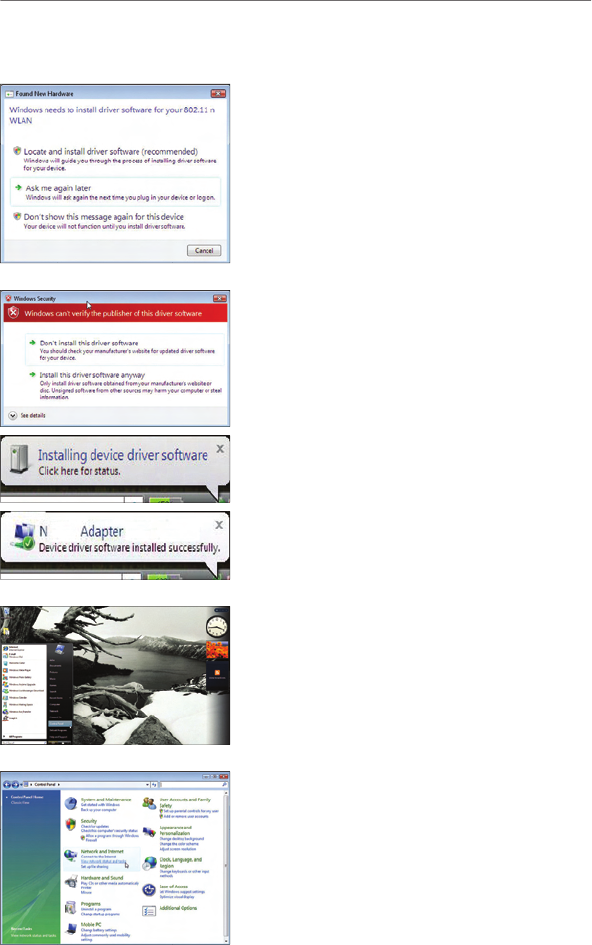
Installing and Setting up the Card
10
A.9
A.9
The Found New Hardware Wizard
might appear within 3–15 seconds.
If it does, continue to follow the
prompts. Select “Locate and install
the driver software” to continue.
A.10
You might see a screen similar to
the one pictured below. This DOES
NOT mean there is a problem. Our
software has been fully tested and
is compatible with this operating
system. Select “Install this driver
software anyway” and follow the
on-screen instructions.
Next, a screen appears indicating
that hardware installation is taking
place; then, another indicates that
the process is complete.
A.11
To connect to the Internet, open the
Network and Sharing Center by first
opening the Control Panel from the
“Start” menu.
A.12
In the Control Panel, click on “View
network status and tasks”.
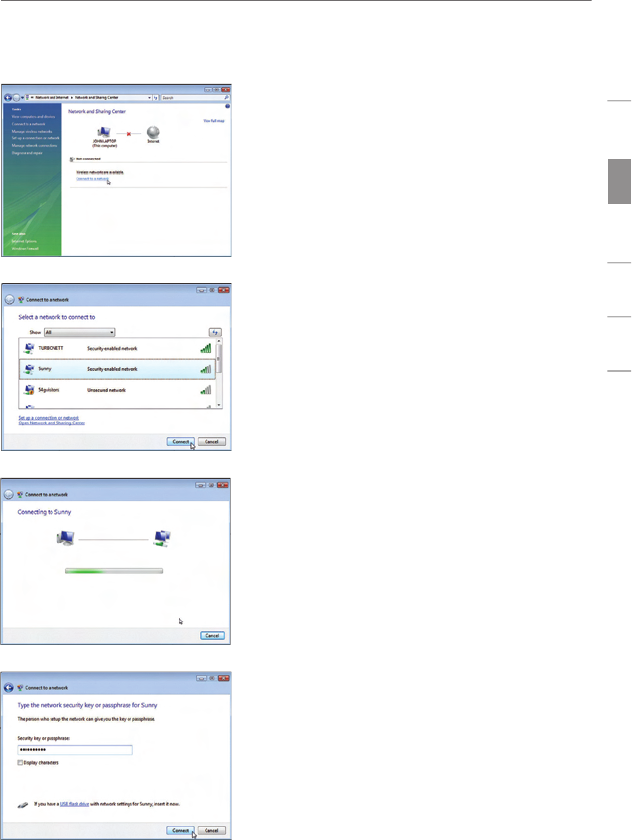
Installing and Setting up the Card
section
11
1
2
3
4
5
6
A.14
In the next screen, select an
available wireless network and
click “Connect”.
A.13
In the Network and Sharing Center,
click on “Connect to a network”.
A.15
Your Card will attempt to connect to
the selected network.
A.16
Depending on the security settings
of your wireless network, you may
be prompted to enter a network
security key or a passphrase. Click
“Connect” after you have done so.
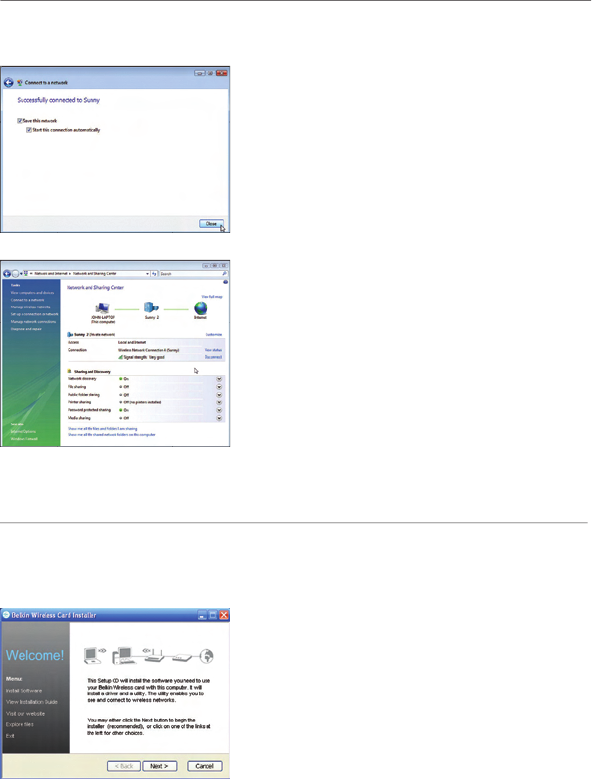
Installing and Setting up the Card
12
B. IInstallation Process for Windows Operating Systems other than
Windows Vista
IMPORTANT
:
INSTALL THE SOFTWARE BEFORE INSERTING THE CARD.
B.1
Insert the Installation Software CD into your CD-ROM drive.
A.17
After connecting to the network,
you can choose to save this
network and connect automatically
when your Card is in range.
A.18
The Network and Sharing
Center now indicates the
network connection that you have
just made. The links on the left of
the window allow you to configure
your network connections.
B.2
The Belkin Wireless Card Installer
screen will automatically appear
within up to 20 seconds. Click
“Install Software” or “Next” to
start the installation.
Note
: If the Belkin Wireless Card
Installer screen does not appear
within 20 seconds, access your
CD-ROM by double-clicking on
the “My Computer” icon; then,
double-click on the CD-ROM drive
into which the installation CD has
been placed. Then, double-click on
the icon named “Setup.exe”.
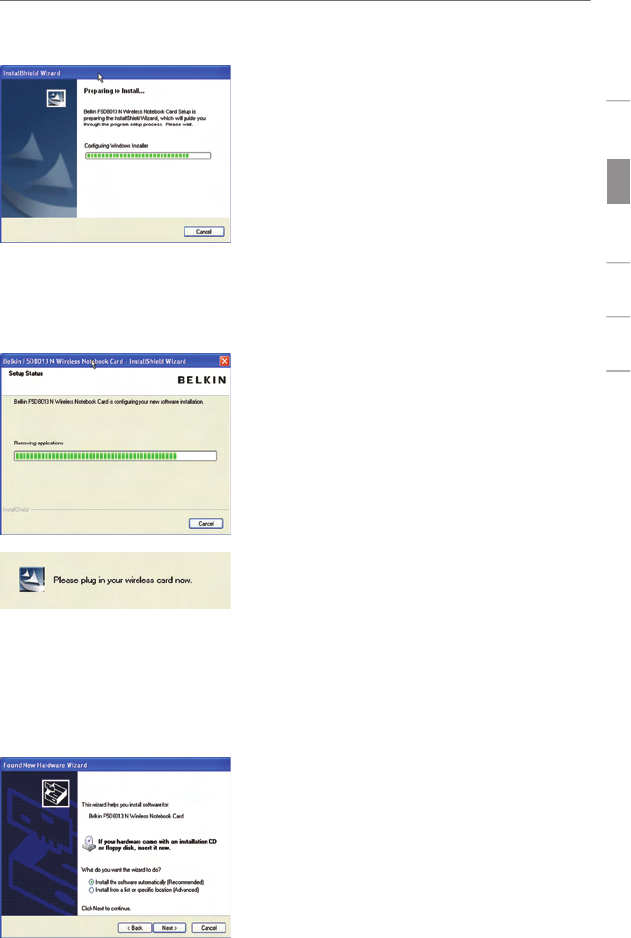
Installing and Setting up the Card
section
13
1
2
3
4
5
6
B.3
The InstallShield Wizard starts the
installation process.
B.4
Select a destination folder for the
software installation by clicking
“Browse”; or, simply click “Next” to
select a default location.
B.6
After the software installation is
finished, a prompt will instruct
you to insert the Card into your
computer’s CardBus slot.
B.5
A Setup Status screen lets you know
where you are in the setup process.
B.7
The Found New Hardware Wizard
might appear in 3–15 seconds. If
it does, select “Install the software
automatically” and click “Next” to
install the hardware.
B.8
If the Found New Hardware Wizard
does not appear, click “Finish”.
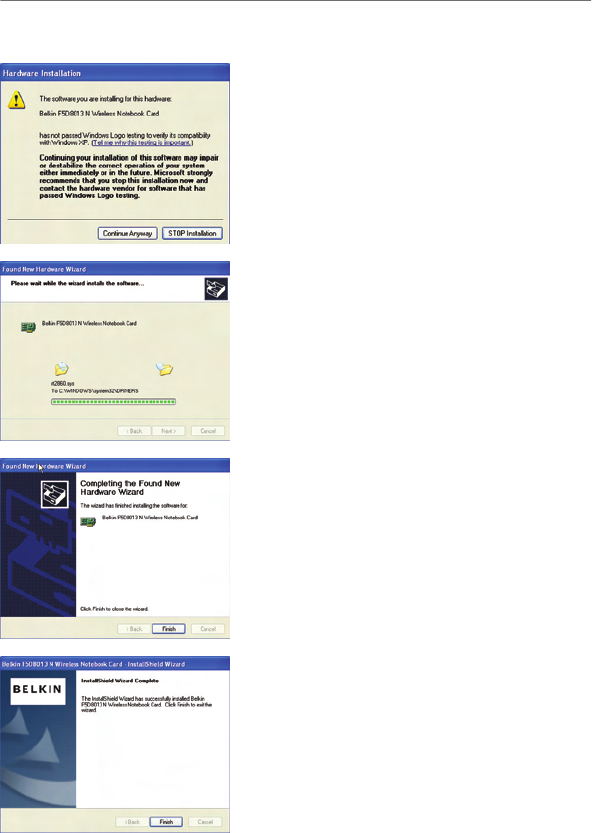
Installing and Setting up the Card
14
B.9
You might see a screen similar to
this one. This DOES NOT mean
there is a problem. Our software has
been fully tested and is compatible
with this operating system. Select
“Continue Anyway” and follow the
on-screen instructions.
B.10
The Wizard will now install
your software.
B.11
The installation is now complete.
Click “Finish” to close the “Found
New Hardware Wizard”.
B.12
Click “Finish” again to exit the
InstallShield Wizard.
B.13
Depending on which operating system
you are using, you might be required to
reboot your computer for the changes
to take effect. Save your data and close
all other applications. Then, reboot.